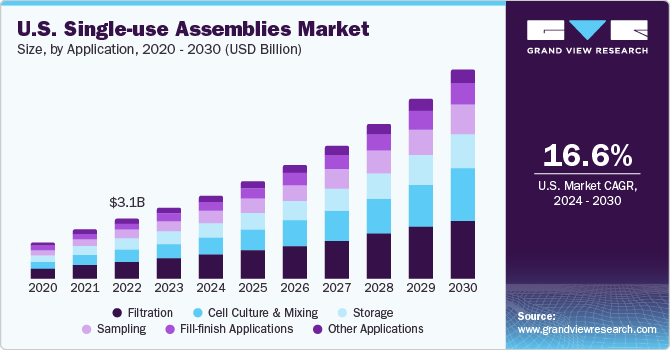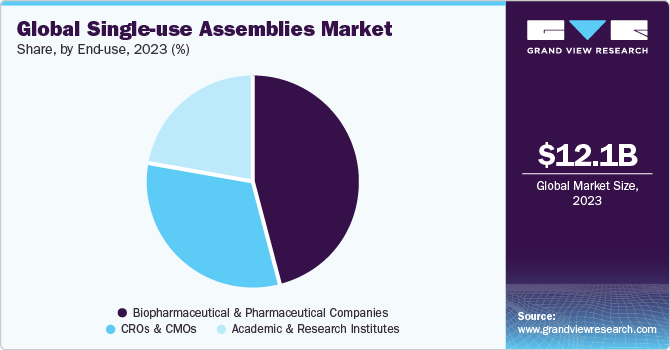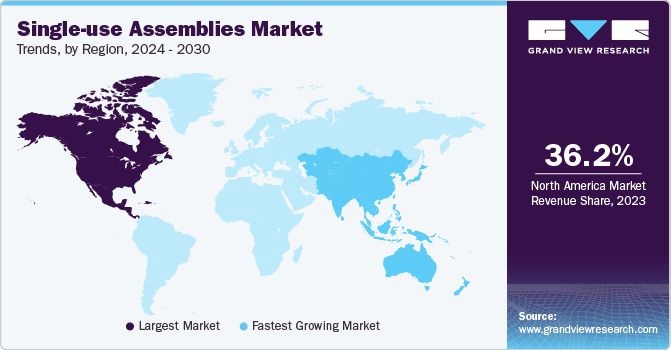- Home
- »
- Biotechnology
- »
-
Single Use Assemblies Market Size & Share Report, 2030GVR Report cover
![Single-use Assemblies Market Size, Share & Trends Report]()
Single-use Assemblies Market Size, Share & Trends Analysis Report By Product (Bag Assemblies, Filtration Assemblies), By Application (Filtration, Storage), By Solution (Customized Solution, Standard Solution), By End-use, By Region, And Segment Forecasts, 2024 - 2030
- Report ID: GVR-4-68039-978-9
- Number of Report Pages: 130
- Format: PDF, Horizon Databook
- Historical Range: 2018 - 2022
- Forecast Period: 2024 - 2030
- Industry: Healthcare
Single-use Assemblies Market Size & Trends
The global single-use assemblies market size was valued at USD 11.89 billion in 2023 and is expected to grow at a compound annual growth rate (CAGR) of 16.53% from 2024 to 2030. Single-use (SU) assemblies are preassembled plastic fluid paths and self-contained products. They are built with a combination of various standard components and are usually ready-to-use and gamma-irradiated to ensure sterility. Broadly used industrial products include sampling bottles, filters, tubings, check valves, clamps, sterile connectors, fittings, and seals. The growing biologics market, continuous technological innovations in bioprocessing, increasing biopharmaceutical R&D, and widespread adoption of single-use assemblies by various CMOs are expected to boost the industry growth during the forecast period.

Regulatory concerns due to leachable and extractable waste disposal, and vast availability of the multi-use system can hinder market penetration to a certain extent. COVID-19 has augmented an already rapidly rising demand for disposable assemblies as the disposable assemblies’ technology allows for speedy production and development of therapies and vaccines and improves accuracy and time. Aramus single-use bag assembly developed by Entegris, Inc. was used for storing COVID-19 vaccines as the vaccines need extremely low temperatures to preserve. With low leachable and extractable and an extensive operating-temperature variety, the patented disposable bags were ideal for cold chain storage and collection.
The growing prevalence of cancer and infectious diseases is increasing the production of effective novel biologics options for the diagnosis and treatment of cancer. A rise in the cases of infectious diseases, such as lower respiratory infections and Human Immunodeficiency Virus (HIV), in recent years due to climate change, changing land-use patterns, and rapid urbanization are expected to aid in the industry growth. For instance, according to the WHO, lower respiratory infections ranked fourth place in causing deaths globally. According to UNAIDS, there were approximately 38.4 million cases of HIV across the globe in 2020.
Infectious diseases require effective diagnosis and treatment options, such as biologics, which, in turn, is expected to boost industry growth. Furthermore, novel developments in vaccines for various infectious diseases are expected to contribute to industry growth. For instance, in January 2022, Moderna launched a new clinical trial for an HIV vaccine that utilizes mRNA technology similar to that found in the company’s COVID-19 mRNA vaccine. This vaccine is aimed at the production of antibodies that can neutralize HIV particles and such attempts highlight the use of recently developed technologies in the biologics space.
Similarly, emerging infectious diseases with the potential to develop into future pandemics are leading to collaborative efforts for the development of new vaccine alternatives. For instance, in August 2022, Lytic Solutions, which offers various molecular biology tools for research use, signed an agreement with NightHawk Biosciences to support NightHawk’s vaccine development efforts toward a new subunit monkeypox vaccine. Hence, such technological developments and collaborative efforts can significantly drive the adoption of SU assemblies for the production of newly developed vaccines in the near future.
The SU assemblies aid in the cost reduction associated with complex steps, such as the maintenance of steel-based bioreactors and accessories, cleaning, and sterilization. This cost reduction by the application of disposable products significantly helps in reducing the R&D costs and initial investments involved in the production of biologics. Moreover, the adoption of disposable assemblies helps in increasingproductivity in the manufacturing process by decreasing the complexity of automation and eliminating the need for changeover validation or cleaning between consecutive operations.
These products have observed more traction in the biologics manufacturing industry where they are being used at multiple stages, namely in the upstream process, media & buffer preparation, downstream process, and process-intermediate storage. By outsourcing, the leading companies can target new product development and rely on the CMO for meeting the clinical as well as commercial manufacturing needs. As a pipeline product moves from phase trials to a fully developed commercial manufacturing stage, the corresponding SUT development can happen concurrently at the CMO to speed up the market penetration of the product.
Market Dynamics
Incorporating SU assemblies in the manufacturing process can reduce the time spent on preparation, documentation, setup, and validation. These assemblies can significantly reduce labor costs and enable rapid product changeover & batch turnaround. Furthermore, product cross-contamination is a common issue in the healthcare industry; this risk can be reduced by using disposable products. These assemblies can also be tailored to specific applications, allowing companies to design assemblies that meet their unique requirements. Thus, such advantages associated with single-use products in the bio manufacturing process can drive the market during the forecast period.
Moreover, leading companies are increasingly outsourcing their manufacturing needs to Contract Manufacturing Organizations (CMOs) to focus on new product development. As a product progresses from clinical trials to full-scale commercial production, the development of corresponding disposable technology can occur concurrently at CMOs, expediting market entry. In recent years, more CMOs have integrated single-use technologies into their bioprocesses, employing single-use assemblies to expedite processing and streamline process changeovers.
The agility and turnaround time offered by single-use equipment can enhance CMO efficiency and reduce overall costs. Furthermore, an increasing number of CMOs have transitioned to predominantly single-use setups to save costs and reduce operating expenses & capital investments. Hence, such widespread adoption of single-use technologies by CMOs represents a promising growth opportunity in the market.
Product Insights
Filtration assemblies held the highest market share of around 28.83% in 2023. Increased regulatory prospects and the need to diminish the risk of contamination have promoted the use of filtration assemblies for bulk and final fill operations. Single-use filtration assemblies are a flexible and efficient alternative to stainless-steel systems as they eradicate sterilization steps and the related validation protocols. The bag assemblies segmentis expected to grow at the fastest CAGR of 18.26% from 2024 to 2030. In the biopharmaceutical industry, single-use bag assemblies of various sizes & shapes are used for many different applications, such as cell cultivation, formulation, sampling bag, buffer medium, and feed-process among others.
Moreover, the extended application of SU bags throughout the bio manufacturing processes has further resulted in its use in drug substance transportation. SU bag assemblies allow rapid assembly and configuration of an extensive range of sterile, fluid-processing circuits. These bags also provide an attractive option for shipping and bulk freezing. Furthermore, advantages, such as lesser maintenance cost & capital investment and lower shipping costs due to less weight and no need for validation or cleaning, will further drive the adoption of bag.
The bag assemblies segment is further divided into 2D and 3D. 2D bag assemblies held the largest share owing to factors, such as advancements in technology. For instance, The Aramus single-use 2D bags are made of a high-quality, gamma-stable fluoropolymer, offering greater compatibility, higher purity, and enhanced safety for final products and critical process fluids. The Aramus single-use 2D bags are made with novel single-layer technology and offer the broadest operational temperature range, making them more robust in cold applications (to -85°C [-121°F] or lower) without destructively affecting the film.
Application Insights
The filtration segment dominated the industry in 2023 andaccounted for a revenue share of 28.83%. SUTs save not only expense and time, but also 90% of integrity testing, sterile connections, and tubing time. They save process time as they are ready to use, unlike conventional filtration systems. The commercial success of biopharmaceuticals will require multiple manufacturing facilities to meet the increasing market demand. Biopharmaceutical manufacturers are integrating single-use facilities for faster product turnaround time and to house multiple product manufacturing processes in the same manufacturing area.
The cell culture & mixing segment is expected to register the fastest CAGR of 18.66% from 2024 to 2030. The growth is mainly driven by the rising demand for biopharmaceuticals, favorable governmental policies, and increasing investment in R&D. Moreover, augmented demand for mammalian cell lines in upstream bioprocessing is further driving the industry. Currently, biopharmaceutical companies and researchers are progressively using cell culture techniques to develop vaccines for a broad range of diseases including rubella, polio, smallpox, chickenpox, and hepatitis. Furthermore, the increasing prevalence of infectious diseases such as COVID-19 and chronic diseases globally will provide a strong impetus to the growth of the market during the study period.
Solution Insights
Based on solutions, the industry has been categorized into customized solutions and standard solutions. Customized solutions dominated the market in 2023 and accounted for the largest share of 71.57%. With a single order, pharmaceutical companies, labs, and other end-users can effortlessly integrate the systems into their process, coupled with streamlining production, and reducing the hassle of sterilizing and cleaning. The majority of players offer customized solutions as per the needs of the users. Mobius single-use assemblies manufactured by MilliporeSigma provide flexible, customized single-use solutions to fast-track pharmaceutical manufacturing and drug development.
Manufacturers who provide custom solutions to end-users offer valuable insight into producing systems which address supply chain constraints, component incompatibility, and fit-for-purpose requirements while at the same time help the customers to safeguard that the system evolves to meet the forthcoming needs.
Major market players such as Sartorius AG, Thermo Fisher Scientific, Inc, Merck, and Danaher have been continuously advancing technologies for these SU systems and providing a wide variety of custom products to meet the growing demand of biopharmaceutical industry. Furthermore, the ongoing developments and expansion of product portfolios have further driven the bioprocessing industry to integrate these customized products into the bio manufacturing processes.
End-use Insights
Biopharmaceutical & pharmaceutical companies dominated the industry in 2023 and accounted for the highest share of 49.38%. The growth of the current manufacturing facilities for biopharmaceuticals drives the demand for single-use assemblies. For instance, in June 2022 Alexion invested USD 70 million in novel drug production warehousing facilities and equipment to enhance Alexion’s manufacturing in Ireland. The expansion aims to expand the biologics drug substance portfolio. Similarly, in May 2022 Upperton Pharma Solutions announced an investment of USD 16 million in the facility expansion that can significantly aid in the increase in R&D space and a 10-fold increase in GMP manufacturing space.

CROs & CMOs are expected to grow at the fastest CAGR of 17.59% during the forecast period. In recent years, CMOs have been integrating SUT into most of their bioprocess. CMOs broadly use single-use assemblies for quicker processing and process changeover time. The short turnaround time and flexibility between process runs and various client projects allowed by single-use equipment can enhance the CMO efficiency, which, in turn, aids in the reduction of overall costs. In addition, the growing number of CMO facilities are essentially fully single-use. CMOs adoption of single-use technology can save on campaign and facility costs, which supports in reduction of operating costs and capital investments.
Regional Insights
North America dominated the market with a share of 36.50% in 2023. This major share can be attributed to the growth in the biotechnology and pharmaceutical industries, advancement in products, and increasing incidence of diseases such as cancer coupled with investments and funding in drug discovery research. For instance, in August 2022 Thermo Fisher Scientific Inc., opened its single-use technology manufacturing site in Greater Nashville. The 400,000-square-foot USD 105 million facilities allow the company to meet the increasing demand for the bioprocessing materials required to produce breakthrough therapies and vaccines for cancer and other diseases.

This site is part of the company’s USD 650 million multi-year investment to develop its bioprocessing production capabilities.Asia Pacificis estimated to register the fastest CAGR from 2024 to 2030 owing to the strategic activities of key players. In 2021, Sartorius made extensive investments in China and Beijing, where additional cleanroom space was created to produce bags and single-use filters. In September 2021, Cytiva announced to build a disposable manufacturing facility in South Korea with an investment of USD 52.5 million. This expansion is aimed to deliver single-use bags to the bioprocessing industry, which are used in COVID-19 vaccine production.
Key Companies and Market Share Insights
Key players are adopting various organic and inorganic strategies, such as partnerships, mergers & acquisitions, geographical expansion, and strategic collaborations, to expand their market presence. For instance, in May 2023, Getinge announced an agreement to acquire the complete shares of Purity New England, Inc. Purity New England Inc. is a market leader in single-use technologies for bioprocessing applications.
- In April 2023, Merck KGaA launched Ultimus, a SU process container film, to provide superior strength & leak resistance in single-use assemblies. In April 2022, Thermo Fisher Scientific developed a new SU manufacturing site in Utah, U.S. With this Utah facility, (part of the USD 650 million multi-year expansion plan), the company envisions providing bioprocessing solutions at even inland locations.
- In August 2023, Trelleborg Healthcare and Medical launched the BioPharmaPro family of advanced products and services for fluid path single-use equipment to boost the development of advanced therapies.
Key Single-Use Assemblies Companies:
- Thermo Fisher Scientific, Inc.
- Merck KGaA
- Sartorius AG
- Danaher Corporation
- Avantor
- Lonza
- Saint-Gobain
- Corning Incorporated
- Entegris
- KUHNER AG
Single-use Assemblies Market Report Scope
Report Attribute
Details
Market size value in 2024
USD 13.83 billion
Revenue forecast in 2030
USD 34.64 billion
Growth rate
CAGR of 16.53% from 2024 to 2030
Base year for estimation
2023
Historical data
2018 - 2022
Forecast period
2024 - 2030
Report updated
November 2023
Quantitative units
Revenue in USD million/billion and CAGR from 2024 to 2030
Report coverage
Revenue forecast, company ranking, competitive landscape, growth factors, trends
Segments covered
Product, application, solution, end-use, and region
Regional scope
North America; Europe; Asia Pacific; Latin America; MEA
Country scope
U.S.; Canada; Germany; UK; France; Italy; Spain; Denmark; Sweden; Norway; Japan; China; India; South Korea; Australia; Thailand; Brazil; Mexico; Argentina; South Africa; Saudi Arabia; UAE; Kuwait
Key companies profiled
Thermo Fisher Scientific, Inc.; Merck KGaA; Sartorius AG; Danaher Corporation; Avantor; Lonza; Saint-Gobain; Corning Incorporated; Entegris; KUHNER AG
Customization scope
Free report customization (equivalent up to 8 analyst’s working days) with purchase. Addition or alteration to country, regional and segment scope.
Global Single Use Assemblies Market Report Segmentation
This report forecasts revenue growth at global, regional, and country levels and provides an analysis of the latest industry trends in each of the sub-segments from 2018 to 2030. For this study, Grand View Research has segmented the global single-use assemblies market report based on product, application, solution, end-use, and region:
-
Product Outlook (Revenue, USD Million, 2018 - 2030)
-
Bag Assemblies
-
2D bag assemblies
-
3D bag assemblies
-
-
Filtration Assemblies
-
Bottle Assemblies
-
Tubing Assemblies
-
Other Products
-
-
Application Outlook (Revenue, USD Million, 2018 - 2030)
-
Filtration
-
Cell Culture & Mixing
-
Storage
-
Sampling
-
Fill-finish Applications
-
Other Applications
-
-
Solution Outlook (Revenue, USD Million, 2018 - 2030)
-
Customized Solutions
-
Standard Solutions
-
-
End-use Outlook (Revenue, USD Million, 2018 - 2030)
-
Biopharmaceutical & Pharmaceutical Companies
-
CROs & CMOs
-
Academic & Research Institutes
-
-
Regional Outlook (Revenue, USD Million, 2018 - 2030)
-
North America
-
U.S.
-
Canada
-
-
Europe
-
UK
-
Germany
-
France
-
Italy
-
Spain
-
Denmark
-
Sweden
-
Norway
-
-
Asia Pacific
-
Japan
-
China
-
India
-
South Korea
-
Australia
-
Thailand
-
-
Latin America
-
Brazil
-
Mexico
-
Argentina
-
-
Middle East and Africa
-
South Africa
-
Saudi Arabia
-
UAE
-
Kuwait
-
-
Frequently Asked Questions About This Report
b. The global single-use assemblies market size was estimated at USD 11.89 billion in 2023 and is expected to reach USD 13.83 billion in 2024.
b. The global single-use assemblies market is expected to witness a compound annual growth rate of 16.53% from 2024 to 2030 to reach USD 34.64 billion in 2030.
b. The filtration assemblies segment held the highest share of 28.83% of the market in 2023. Increased regulatory prospects and the need to diminish the risk of contamination have promoted the use of filtration assemblies for bulk and final fill operations.
b. The key market players key competing in the single-use assemblies market include Thermo Fisher Scientific, Inc, Sartorius AG, Danaher Corporation, Merck KGaA, and others.
b. The growing biologics market, continuous technological innovations in bioprocessing, increasing biopharmaceutical R&D and widespread adoption of single-use technology by various CMOS are some of the major factors driving the growth of the single-use assemblies market.
Share this report with your colleague or friend.
![gvr icn]()
NEED A CUSTOM REPORT?
We can customize every report - free of charge - including purchasing stand-alone sections or country-level reports, as well as offer affordable discounts for start-ups & universities. Contact us now
![Certified Icon]()
We are GDPR and CCPA compliant! Your transaction & personal information is safe and secure. For more details, please read our privacy policy.
We are committed towards customer satisfaction, and quality service.
"The quality of research they have done for us has been excellent."





